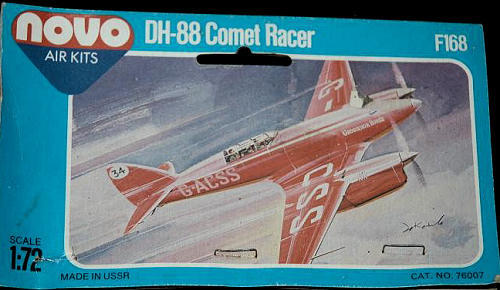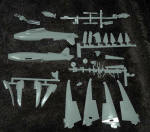
Novo 1/72 DH.88 Comet Racer
| KIT #: | F168 |
| PRICE: | $ cheap at a swap meet |
| DECALS: | One Option |
| REVIEWER: | Zac Yates |
| NOTES: |

| HISTORY |
The de Havilland DH88 was one of many aircraft built during the interwar period solely for racing, and one of the few to gain long-lasting fame. A firm known mainly for light aero club aircraft, the company’s chief designer and founder Geoffrey de Havilland also produced several fighter and bomber designs during the Great War under the auspices of Airco.
The DH88 originated
following the 1934 announcement of an air race to celebrate the centennial of
the city of
The true legacy of the five Comets, beyond their racing and records, was that the plywood construction of the sleek aircraft led to the development of the supremely elegant DH91 Albatross airliner, and ultimately to that jack-of-all-trades, the superlative DH98 Mosquito.
Today only the
race-winning G-ACSS remains intact, in an airworthy condition but rarely flown,
with the Shuttleworth Collection at Old Warden,
| THE KIT |
 This
kit is a Novo reissue of the original FROG kit, also market in the
This
kit is a Novo reissue of the original FROG kit, also market in the
Surface detail is raised and restrained on the fuselage. The sparse lines on the aircraft, when compared with photographs of G-ACSS, appear to be correct. The trailing edges of the wings and the control surfaces all have raised lines to represent fabric detail, which will need to be sanded off by the builder concerned with total accuracy.
The interior is also, typical of a kit this vintage, very sparse – two seats, and pilots to place on them. The cockpit opening is very small, but the enterprising builder can add sidewall detail and instrument panel. I believe there is a complete aftermarket resin ‘pit available, for those who want to go all out. The canopy is, however, moulded as one piece, so careful cutting will be needed to have it open. The canopy is commendably thin, but perhaps too streamlined: compared with photos of the real thing, it is shallow and altogether too curved.
The undercarriage is fiddly enough to keep you busy, but appears to be a faithful representation, down to the stylish wheel fairings. The instructions give you the option to have retracted gear, and a recess is thoughtfully provided under the wing for this.
The horizontal stabilisers are moulded in halves, which will mean substantial sanding to obtain the correct thickness (this would also mean sanding the elevators, so you may choose to leave them be). The props, although finely moulded, appear too paddle-like and may need replacement. The nacelles are incorrectly moulded with the intake central, rather than offset to port as on the real machine.
Smaller components, such
as exhausts, mass balances and pitot tube, are not included, but the landing
light on the nose is shown with a clear piece. Finally, two standing pilot
figures (representing Tom Campbell-Black and Charles Scott, 1934 race-winning
crew of ‘
Decals in my copy appear very nice but thick, proving race number, registrations, name and the fuselage cheat line. However I have my doubts as to how well mine have aged, so I may track down an aftermarket set or make do with my own. Due to the fact that they’re almost entirely white, and the yellowing, I decided not to include an image of them for this preview.
| CONCLUSIONS |
This is one of two 1/72 injection-moulded Comet kits available over the years, the other being Airfix’s veteran 1:72 kit. The Airfix issue is a fairly nice kit, but I believe the Novo one walks right over it. The Airfix kit has a thick canopy, non-existent interior (two head shapes are instead moulded on the fuselage halves), large wing-fuselage seams which are awkward to fix, and no clear landing light. It does, however, correctly have the offset intakes.
The Novo kit overall gives the impression of needed less work to be done right, with the major faults being the shallow canopy and central nacelle intakes. The canopy area lets the kit down, but with a replacement canopy – if available – and some cutting, it provides no major obstacle.
Overall I’d recommend the FROG/Air Lines/Novo Comet, which pops up from time to time on eBay.
February 2009
If you would like your product reviewed fairly and quickly , please contact me or see other details in the Note to Contributors.